
The West Thames Pedestrian Bridge over West Street
The intersection of West Thames and West Street connects the NYC Financial District to Battery Park City. This is also where the Brooklyn Battery tunnel empties into Manhattan. Here are 3 pedestrian crossing options:
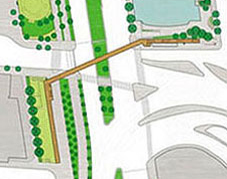
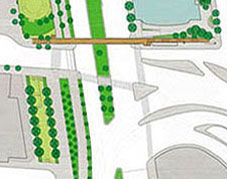

In June of 2009, a 21-million-dollar pedestrian bridge at the intersection of West Thames and West Street connecting the Financial District to Battery Park City was announced.

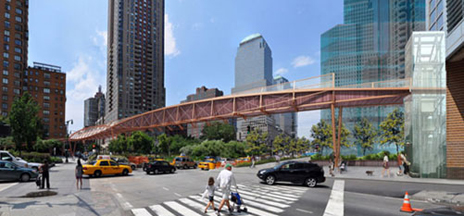
The bridge has 3 angled sections with an elevator and ramp at one end, and stairs & ramp at the other. This plan:
• Adds to the literal and visual chaos of the intersection.
• Requires the removal of an entire row of trees.
• Removes shade from one side of the dog park.
• Does not integrate into the order and alignment of the naborhood.

Above: Elevation of the bridge ramp and staircase along the dog park. Below: The row of trees that will be cut down.

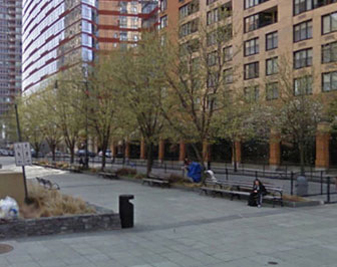
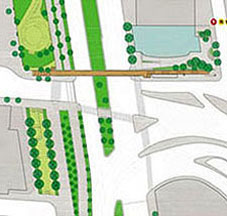
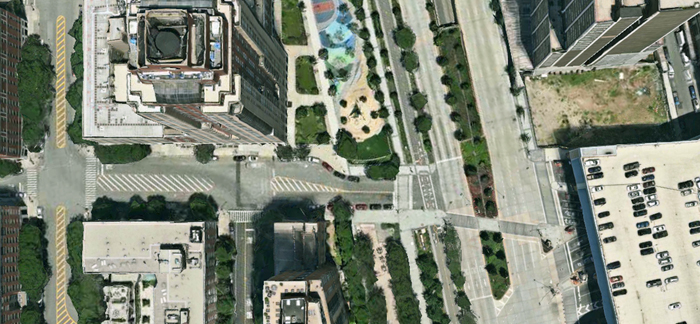
In this more obvious and intuitive solution, the bridge goes straight across West Street and terminates with an elevator and a staircase on the west and an elevator and ramp or stair/ramp on the east. A few advantages:
• While it may seem hard to integrate the philosophies of organic architecture in an urban setting, the existing sidewalk locations, dimensions, and curves look custom made for the western landing to be on the north side of Thames Street. That side better respects and maintains the fabric of the naborhood by integrating the bridge with the alignment of the existing street and building grid.
• The new bridge will serve the residential buildings along Rector Place, South End Avenue, Thames, and Battery Place. Residents farther south will likely use the crosswalk at Battery Place or 2nd Place/Morris Street. As residents from Rector Place and West Thames walk to the financial district or to the subways along Rector Street, many will not have to cross Thames Street.
• The distance of the bridge span would be as short as feasible, thus requiring less material.
Option 2 would be the most convenient for the most people, fit the site better by respecting the existing grid and alignment, enhance the naborhood aesthetics and quality of life, maintain the most existing trees, and be more cost efficient.


This option acknowledges that crossing the intersection, with barriers, stoplights, crossing guards and a nearby police presence is quite safe and convenient. The State Department of Transportation has added some traffic-calming features, including colored crosswalks, more than 500 trees in the median, additional time for pedestrians to cross, countdown signals, and reducing the speed limit from 35 miles per hour to 30.
• The city cannot guarantee anyone's safety. People should take responsibility for their safety - making smart decisions at busy intersections. They should guide and set an example for their children.
• The intersection is already quite safe - traffic signals with Walk and Don't Walk signals, concrete and stone barrier walls, protected median landing, landscaping, recently funded crossing guards, and police officers within a few yards. There is no evidence that the intersection of West Street and Thames is dangerous.
• With or without the bridge, school kids have to cross a street before they get home. This particular intersection is quite safe for any person taking responsibility and paying attention to the signals.
• This option would save the city millions of dollars.
6 years later: Proposal #2

The 2009 proposal never got adequate funding, went through a lengthy public design review, and hit some bureaucratic and design snags. The snags were finally resolved and a new proposal was presented in 2014. The revised West Thames bridge is a 240-foot-long concrete and steel structure with a glass roof and is expected to cost $27.5 million (not including any certain-to-come overcharges). It will be accessible by stairs and elevators on each end. With no ramp along the dog park, fewer trees will have to be removed. As of November 2015, ground has not been broken for the bridge. The project has been stalled by arguments over which agency will absorb any cost overruns. The most recent official estimates are that construction will begin on the West Thames pedestrian bridge sometime in 2016, with no projected completion date yet announced.


Above left: In 2015, the canopy over the staircase was deleted. Below left: Proposed layout. Right: Option that is cheaper, requires removal of fewer trees, better respects the urban grid, is visually more appealing, and provides a more convenient walking option.


Walking patterns:

